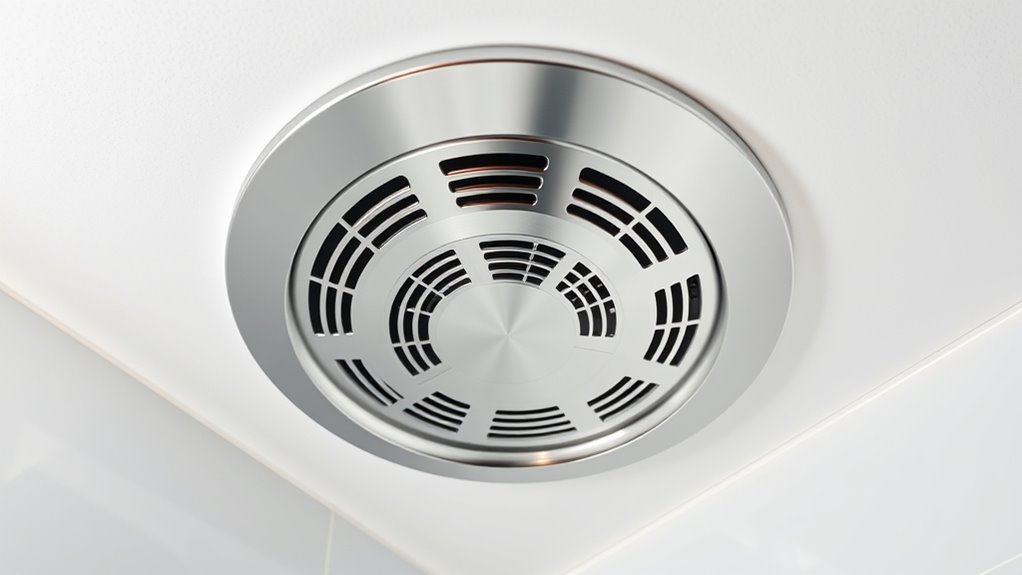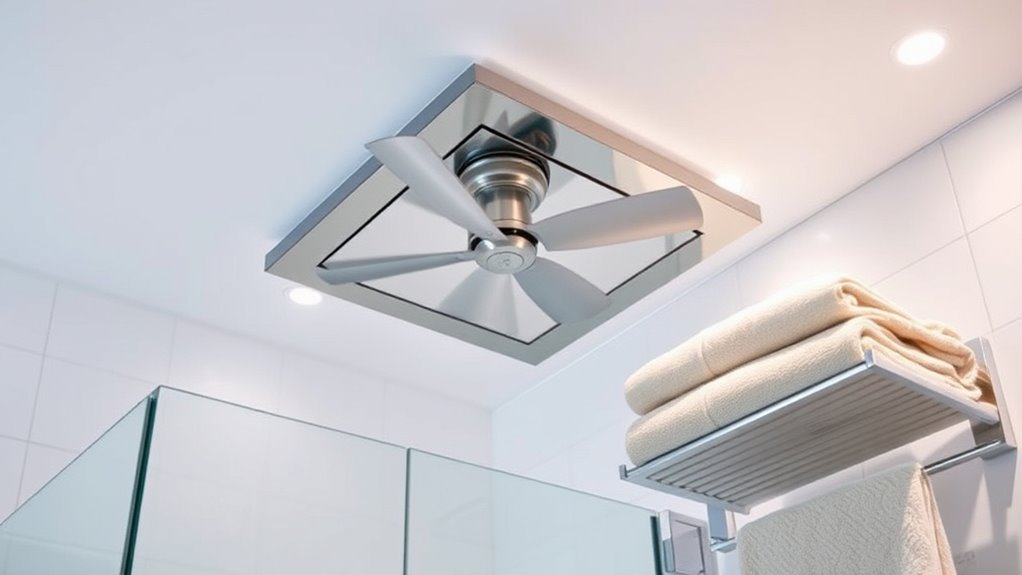To avoid regrets, make sure you use your bathroom vent fan properly. Turn it on during showers and leave it running for at least 20 minutes afterward to clear out moisture. Proper sizing, correct installation, and venting directly outside are key. Regularly clean the grille and inspect ductwork to keep it working efficiently. Neglect these steps, and mold or damage could develop. Want to know the best practices to maximize your fan’s performance? Keep exploring.
Key Takeaways
- Turn on the fan during and after showers for at least 20 minutes to effectively remove moisture.
- Properly size and install the fan with correct ducting to ensure optimal performance and moisture extraction.
- Regularly clean the grille, inspect ductwork, and maintain blades to prevent inefficiency and mechanical issues.
- Vent the fan directly outside to avoid indoor humidity buildup and mold growth.
- Neglecting proper use or maintenance can lead to mold, structural damage, and reduced fan lifespan.

Have you ever wondered why bathroom vent fans are so crucial? They might seem like a small, simple fixture, but they serve an essential role in keeping your bathroom safe, comfortable, and hygienic. When you take a shower or bath, a lot of moisture, steam, and humidity build up quickly. Without proper ventilation, that excess moisture can cause serious problems, including mold growth, peeling paint, and damage to your walls and ceilings. A bathroom vent fan helps remove this damp air efficiently, preventing long-term damage and making your space more pleasant to use.
Using your vent fan correctly makes a significant difference. Many people forget to turn it on or leave it running for only a few seconds after they finish their shower, but that’s not enough. To truly benefit, you should run the fan during your shower and keep it on for at least 20 minutes afterward. This ensures that all the moisture gets expelled from the room. If you neglect to use it or turn it off too soon, the humidity lingers, creating an environment conducive to mold and mildew. Not only does this compromise your home’s structural integrity, but it can also pose health risks, especially for those with allergies or respiratory issues.
Another common mistake is installing a fan that’s too small or underpowered for your bathroom’s size. A fan that’s not appropriately rated won’t remove moisture effectively, leaving your bathroom vulnerable to the same problems. Conversely, an oversized fan can be noisy and waste energy. To get it right, measure your bathroom carefully and select a fan with the right cubic feet per minute (CFM) rating. Larger bathrooms require more powerful fans, while smaller spaces can do with less. Proper installation is equally important. If the fan isn’t vented to the outside, or if the ductwork is blocked or improperly sealed, moisture can still escape into your walls or attic, defeating the purpose altogether. Incorporating sound design principles such as reducing noise can improve user experience and encourage consistent use.
Finally, don’t forget maintenance. Dust, grease, and debris can clog the vent or fan blades, reducing efficiency. Regularly cleaning the grille and inspecting the ductwork ensures your fan continues to operate at peak performance. Neglecting maintenance can lead to noise, overheating, or even mechanical failure, forcing you to replace the entire unit sooner than expected. In short, using your bathroom vent fan correctly and maintaining it properly isn’t just about following rules—it’s about protecting your home, your health, and your peace of mind. If you ignore these simple steps, you’ll regret it later when mold appears or costly repairs become unavoidable.
Frequently Asked Questions
How Often Should Bathroom Vent Fans Be Cleaned?
You should clean your bathroom vent fan at least once every six months. Regular cleaning prevents dust and debris buildup, ensuring it operates efficiently and reduces mold or musty odors. Turn off the power before cleaning, remove the cover, and gently vacuum or wipe down the blades and motor. If you notice reduced airflow or strange noises, clean it more frequently. Proper maintenance keeps your fan working smoothly and prolongs its lifespan.
Can a Vent Fan Be Installed in a Small Bathroom?
A vent fan can definitely be installed in a small bathroom. Remember, “A stitch in time saves nine.” You just need to choose a size that suits your space and guarantees proper airflow. Proper installation is key, so don’t skimp on professional help if needed. Vent fans help prevent mold and odors, making your small bathroom more comfortable and healthier. Go ahead, upgrade your space wisely!
Do Different Fan Sizes Suit Specific Bathroom Sizes?
Yes, different fan sizes suit specific bathroom sizes. You should select a fan with the right airflow capacity, measured in CFM (cubic feet per minute). For small bathrooms, a 50-80 CFM fan works well, while larger bathrooms may need 100-150 CFM or more. Picking the right size guarantees proper ventilation, prevents moisture buildup, and keeps your bathroom fresh without unnecessary noise or energy use.
Are There Energy-Efficient Vent Fan Options Available?
Yes, there are energy-efficient vent fan options available. You can choose models with ENERGY STAR certification, which use less power while maintaining strong airflow. Look for fans with DC motors and lower wattage ratings to save energy. Installing a timer or humidity sensor can also help, ensuring the fan runs only when necessary. These choices help reduce your energy bills and environmental impact while keeping your bathroom well-ventilated.
How Loud Should a Bathroom Vent Fan Ideally Be?
You should aim for a bathroom vent fan around 1.0 to 1.5 sones, which is whisper-quiet—like a gentle breeze. I once installed a louder fan, and every time it turned on, it felt like a jet taking off. A quieter fan guarantees you won’t disturb your morning routine or sleep, so choose one that’s unobtrusive, balancing power and noise for your comfort.
Conclusion
If you ignore proper use of bathroom vent fans, you risk mold, odors, and damage. For example, imagine a homeowner who leaves their fan off after showers; moisture builds up, leading to mold in the walls. But if you use the fan correctly—running it during and after showers—you’ll keep your bathroom dry and healthy. Don’t neglect this simple step. Use your vent fan properly, and you’ll save yourself headaches and costly repairs down the road.









